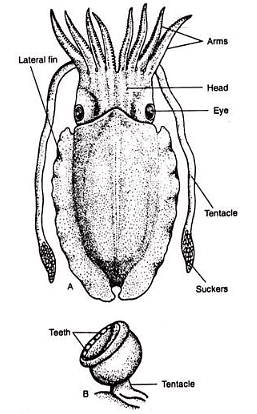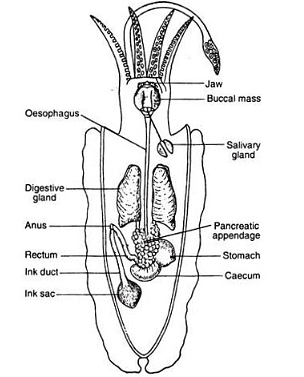UPSC Exam > UPSC Notes > Zoology Optional Notes for UPSC > Molluscs: Sepia
Molluscs: Sepia | Zoology Optional Notes for UPSC PDF Download
Habits and Habitat of Sepia
Introduction
- Sepia belongs to the class Cephalopoda, representing a complex and highly specialized group of molluscs.
- This discussion delves into Sepia's habits and habitat, shedding light on its distinctive features.
- Sepia is commonly known as the cuttlefish.
Marine Habitat
- Sepia exclusively resides in marine environments.
- It typically inhabits the surface waters of the ocean.
- Sepia's habitat includes both shallow and deeper waters.
Swimming Behavior
- Sepia demonstrates proficient swimming abilities.
- They are known to be agile swimmers.
- Their preferred swimming time is during the night, while they tend to rest on the seafloor during the daytime.
- Lateral fins, the funnel, and their arms play vital roles in facilitating swimming.
Burrowing and Group Behavior
- Sepia has the capability to create burrows using its funnel and use fins as shovels to cover their bodies with sand.
- They often move in groups, displaying gregarious behavior.
- These marine creatures are carnivorous and primarily feed on small fish, crustaceans, and other small marine animals.
External Structures of Sepia
Distinct Head and Trunk
- Sepia's body is divided into two main regions: a well-defined head and an elongated, dorso-ventrally flattened trunk.
- A narrow neck connects the head with the trunk.
Oral Arms and Tentacles
- The head bears two prominent eyes and ten oral arms.
- Except for the fourth pair, the oral arms exhibit convex outer surfaces and flat inner surfaces.
- The inner surface of these arms features four longitudinal rows of suckers, which aid in capturing prey or foreign objects.
- The fourth pair of arms, known as tentacles, are longer and have suckers primarily concentrated at their tips.

Mantle and Fins
- A thick mantle covers the trunk, and the margin of the body has thin, lateral, muscular folds known as fins.
- Sepia possesses an internal, bilaterally symmetrical shell, primarily composed of calcareous material, which is also referred to as a cuttlebone.
- The cuttlebone serves both as an endoskeleton, providing structural support, and for buoyancy regulation.
Color Changing Abilities
- Living Sepia has the ability to change their color due to the presence of chromatophores in their integument, allowing them to blend in with their surroundings, such as sand and rocks.
Coelom of Sepia
True Coelom
- Sepia's true coelom is represented by the viscero-pericardial coelom and the cavities in the kidney.
- The viscero-pericardial coelom consists of two parts: the pericardial cavity at the anterior end and the gonocoel at the posterior end.
Digestive System of Sepia
Feeding Habits
- Sepia predominantly feeds on small fish and crustaceans, especially prawns.
- It captures its prey with the help of a circlet of eight short arms.
Oral Structure
- The mouth is encircled by the bases of the ten long oral arms.
- It houses a pair of powerful jaws responsible for cutting food into smaller pieces.

Buccal Cavity and Stomach
- The mouth leads to the buccal cavity, which contains an odontophore and the radula.
- The buccal cavity transitions into a straight, narrow tube called the esophagus.
- The esophagus leads to a two-chambered stomach: the muscular gizzard and the thin-walled caecum.
- The caecum is connected to the intestine, which runs parallel to the esophagus and ultimately terminates at the anus.
Locomotion of Sepia
Swimming Mechanism
- Sepia is an adept swimmer, using the undulatory movement of its lateral fins.
- During rapid movement, Sepia can move backward by forcefully expelling water from the mantle cavity through the siphon.
Respiratory System of Sepia
Respiratory Organs
- The respiratory organs in Sepia are known as ctenidia, and there are two of them.
- These ctenidia have numerous paired, delicately folded lamellae, giving them a bipectinate structure.
- They are attached along a significant portion of the mantle wall.
Circulatory System of Sepia
Highly Developed Circulatory System
- Sepia boasts a highly developed circulatory system.
- The heart consists of two auricles and one ventricle, which is constricted into two lobes.
- The ventricle leads to two aortae, the anterior or oral aorta and the posterior or aboral aorta.

Blood Circulation
- Arteries branching from the aortae supply various body parts.
- The vena cava collects blood from different body regions.
- It bifurcates into precavals, which pass through the kidney and continue as afferent branchial veins supplying the ctenidia.
- The afferent branchial veins dilate at the base of the ctenidia to form a contractile branchial heart, associated with a glandular appendage.
- Blood returns from the ctenidia to the heart via efferent branchial veins.
Excretory System of Sepia
Renal Sac
- Sepia's excretory system consists of a pair of thin-walled renal sacs.
- These sacs communicate with the mantle cavity through separate apertures on each side.
- The sacs also connect anteriorly and posteriorly.
- Surrounding the branchial vein in each sac are masses of glandular tissue that extract nitrogenous waste in the form of guanin.
Nervous System of Sepia
Highly Developed Nervous System
- Sepia possesses a complex and highly developed nervous system.
- It includes cerebral, pedal, pleural, and visceral ganglia.
- These ganglia are closely aggregated around the esophagus.

Sensory Organs
- The sense organs in Sepia are highly developed, comprising eyes, statocysts, olfactory pits, gustatory organs, arms, and tentacles.
- The eyes exhibit unique 'W'-shaped pupils.
- Statocysts help maintain balance and orientation.
- Olfactory pits are potentially involved in the sense of smell.
- Gustatory organs assist in taste perception.
- Arms and tentacles serve as tactile organs.

Reproductive System of Sepia
Separate Sexes and Sexual Dimorphism
- Sepia exhibits separate sexes, and sexual dimorphism is evident.
- Male individuals are distinguished by the presence of hectocotylized arms.
Male Reproductive System
- The male reproductive system consists of a testis enclosed in a capsule.
- The vas deferens is elongated and convoluted, leading to a seminal vesicle.
- The seminal vesicle expands into a sperm sac, which opens into the mantle cavity.
- The prostate is glandular and opens into the seminal vesicle.
- Sperm is encapsulated within spermatophores and stored in a pouch called Needham's sac.
- Hectocotylized arms are involved in transferring spermatophores to the female.

Female Reproductive System
- The female reproductive system comprises a single ovary enclosed in a capsule.
- The oviduct connects to the mantle cavity.
- Nidamental glands secrete substances that help eggs adhere together.

- Development of Sepia involves direct development, where the young resemble adults upon hatching from large, pear-shaped, yolk-rich eggs enclosed in a gelatinous covering.
The document Molluscs: Sepia | Zoology Optional Notes for UPSC is a part of the UPSC Course Zoology Optional Notes for UPSC.
All you need of UPSC at this link: UPSC
|
181 videos|346 docs
|
FAQs on Molluscs: Sepia - Zoology Optional Notes for UPSC
| 1. What are the external structures of Sepia? |  |
Ans. Sepia, also known as cuttlefish, has several external structures including a soft body covered in a mantle, eight arms, two tentacles, a siphon, and a unique internal shell called the cuttlebone.
| 2. How does Sepia move? |  |
Ans. Sepia moves by using its arms and tentacles to swim. It propels itself by expelling water through a tube called a siphon, which allows it to move both forwards and backwards. Sepia can also change its color and texture to camouflage itself in its environment.
| 3. What is the respiratory system of Sepia? |  |
Ans. Sepia has a highly developed respiratory system that allows it to extract oxygen from water. It has gills, which are located in a cavity called the branchial chamber. Water enters the chamber through the siphon and passes over the gills, where oxygen is absorbed and carbon dioxide is released.
| 4. How does Sepia excrete waste? |  |
Ans. Sepia excretes waste through its excretory system, which consists of a pair of renal organs. These organs filter waste products from the blood and excrete them in the form of urine. The urine is then expelled through a small opening called the excretory pore.
| 5. How does Sepia reproduce? |  |
Ans. Sepia has a complex reproductive system. Males transfer packets of sperm, called spermatophores, to females using a specialized arm called a hectocotylus. The female then stores the sperm until she is ready to lay eggs. The eggs are laid in clusters and are attached to underwater structures. After hatching, the young sepias go through a series of developmental stages before reaching adulthood.

|
Explore Courses for UPSC exam
|

|
Signup for Free!
Signup to see your scores go up within 7 days! Learn & Practice with 1000+ FREE Notes, Videos & Tests.
Related Searches



















